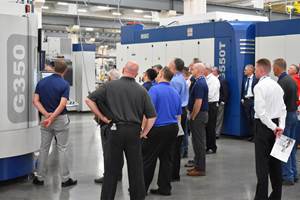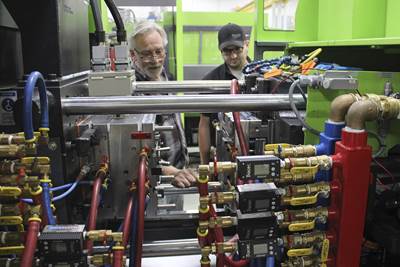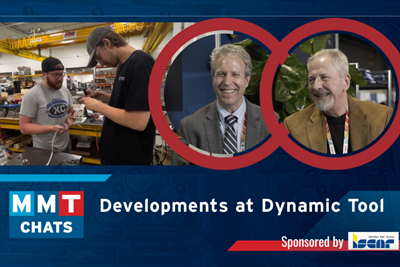Share





Dynamic Tool uses its two Kitamura Bridgecenter 6G#40 machining centers to fabricate these highly customized mold bases. The B-plate shown above is part of a production mold that produces filtering components for a medical device. Tooling techniques such as cam actions, slides, lifters, auto-unscrew, in-mold closing or core toggle require sophisticated A- and B-plates manufactured accurately, efficiently and repeatedly. All images provided by Dynamic Tool Corp.
Founded in 1976, Dynamic Tool Corp. (originally Dynamic Tool & Design) of Menomonee Falls, Wisconsin, is a moldmaker specializing in tools for high-productivity, tight-tolerance, thin-wall injection molding for the medical device, pharma packaging/disposal, caps/closures/dispensers, fluid control, electrical/electronics and personal care segments. With a team of 85, the company produces roughly 80 new and completely refurbished injection molds per year, plus prototype and bridge tooling sized for presses between 20 and 1,000 US tons. Besides conducting molding feasibility studies and designing and building molds, Dynamic also offers preventative mold maintenance, refurbishment, repair, reverse engineering and makes engineering changes to anyone’s tools. The company also offers product sampling and process qualification services for new and repaired molds, plus limited-run injection molding via eight multishot-capable injection presses.
Dynamic also builds and validates complete turnkey manufacturing cells that can include everything from injection presses to automation, custom-control units, fixtures and downstream value-added operations. While the company has offered this service for several decades — initially to support aggressive launch schedules for several high-volume product releases by customers in the personal care market — Dynamic had been increasingly space-constrained in its original facility, which totals 51,000 square feet.

With a team of 85, Dynamic Tool Corp produces roughly 80 new and completely refurbished injection molds/year, along with prototype and bridge tooling. The company also provides product sampling and process qualification services and limited-run injection molding.
A recent purchase of a second facility in the same industrial park will add another 120,000 square feet of floor space when fully renovated. Called the Dynamic Development Center, the new facility will not only house the company’s second metrology lab and its own presses and auxiliary equipment, but it will finally give the team the space they and their customers need to make building and validating turnkey manufacturing cells a larger part of Dynamic’s business. Reportedly, they already have customers lined up to use the service once it’s available again.
Holding Five Microns
One of Dynamic’s claims to fame is its ability to produce tight-tolerance molds and mold components — critical in markets like medical device — and to repeatedly produce replacement components held to the same tolerances as the original mold — because customers with high-volume molding operations expect interchangeability when replacing worn components. It’s no surprise to learn that the company takes metrology very seriously. When required, Dynamic can repeatedly hold 5 micron (0.00020-inch) tolerances on both hard-cutting and sinker EDMs. Not only is requisite equipment fitted with integrated coordinate measuring machines (CMM) on the rail systems, but every component is 100% inspected before moving to the next operation.

Dynamic builds tools for straight injection, multishot/insert molding, in-mold decoration/lamination, hot runner, auto-unscrew, collapsible core, in-mold closing/living hinge and stack molds.
Given this focus on precision machining, in 2021, company leadership decided to expand capacity and add additional CNCs because several older machining centers were starting to show their age. In addition to wanting greater accuracy and reliability and access to newer technologies, the team also desired a machine with greater Y-axis table travel, which was limiting their ability to machine larger mold bases in-house. However, because this was before the new building was purchased, they also had limited floor space.
Working with the manufacturer’s rep, Concept Machine Tool Sales LLC, based in Delafield, Wisconsin, the team decided it was time to upgrade from a C-frame to a double-column bridge-type machining center that could handle bigger and heavier workpieces and gang up multiple smaller blocks for more unattended machining. Initially, three companies were considered. However, two were eliminated because their bridge-style CNCs didn’t offer the Y-axis table travel that Dynamic sought, plus their machine footprint was too large for available space. However, one company had bridge machines that fit the bill: Kitamura Machinery of USA Inc.
“Although Dynamic had never owned a Kitamura, one of our vendors has eight of them and the shop I used to work at has three, so our team knew the company by reputation and we received very positive recommendations from our colleagues.”
“Although Dynamic had never owned a Kitamura, one of our vendors has eight of them and the shop I used to work at has three, so our team knew the company by reputation and we received very positive recommendations from our colleagues,” Scott Matenaer, Dynamic plant manager, recalls.
“Kitamura offers bridge machines with really large travel that also can hold very tight tolerances at high cutting speeds and all the torque you could ever need thanks to its four-speed geared headstock, hand-scraped dimensions and bridge-style design with boxways,” Tom Schweda, Concept Machine Tool territorial sales manager, adds. “When Dynamic needed bigger capacity while maintaining high accuracy in a modest footprint, Kitamura was the logical choice.”

Dynamic also offers preventative mold maintenance, refurbishment, repair, reverse engineering and makes engineering changes to anyone’s tools. The company designs and prints its conformally cooled mold inserts using in-house metal additive printers or external service bureaus.
The People Company
“Kitamura customers expect to purchase a machine that not only will be long lasting but also will maintain its accuracy for the lifetime of the machine — which can be over 20 years,” Slawomir Swierczek, Kitamura Machinery of USA assistant sales manager, explains. “We are very conservative in how we construct our machines, which is done largely by implementing proven engineering practices, like hand scraping and induction hardening of the boxways, which offer advanced levels of rigidity, longevity, and machine accuracy and repeatability.”

In March 2022, two Kitamura Bridgecenter 6G#40 machining centers were installed at Dynamic Tool.
All mounting surfaces on Kitamura machining centers feature hand scraping for improved surface contact as well as parallelism and perpendicularity, so no voids that require shimming are left. Overall, machine mass is said to be heavier than comparable machines of the same class. Plus, Kitamura uses Meehanite (GA50) cast iron construction for critical components, which contributes to rigidity.
Another feature is the use of induction-hardened, thick-walled, ribbed and precision-ground solid boxways, which contribute mass, stability, rigidity and vibration damping during heavy milling to ensure excellent surface finishes and prevent workpiece distortion due to heat buildup. Shockless drive mechanisms provide further vibration damping during milling.
Multistep, gear-drive spindles are said to provide better thermal control for stiffer, more stable cutting performance and an additional thermal compensation system minimizes head displacements to less than 5 microns. Zero-overhang tables and exclusive headstock designs, which are said to completely relieve motor-generated thermal stress on spindle bearings, plus the use of pretensioned, fine-pitch ball screws and high-resolution servo motors, contribute to greater accuracy and the ability to achieve smaller incremental movements for finer surface finishes.
CNC control is also an important factor in machine accuracy. Kitamura’s operating system, called Arumatik-Mi (an anadrome of I’m Kitamura), is designed to be as simple and intuitive to use as a smartphone. The operating system offers 16 gigabytes of storage capacity, 4,500 blocks of processing speed and 8,190 blocks of look-ahead capabilities. Also, 67 million pulse encoder technology helps maintain high accuracy at high cutting speeds. Machines also offer 2-micron/0.00010-inch accuracy on full stroke.
Forty Percent Greater Y-Axis Travel in the Same Space
“We made our decision in the fourth quarter of 2021 to go with Kitamura,” John Kemeny, Dynamic CNC supervisor, recalls. “That was a really difficult time with shortages of everything and huge shipping delays. However, we got lucky as Kitamura had two new, nearly identical bridge machines sitting in crates inside the U.S., so we bought them both.” Dynamic issued a purchase order in November 2021 but needed until March 2022 to get footings poured and cured, existing machines moved and everything ready for delivery. The two stock machines — Bridgecenter 6G models, which the team calculated would handle 95% of all the molds they produce — featured #40 taper spindles running at 20,000 rpm. One CNC was equipped with the standard 60 toolchanger and the other with an 80 toolchanger.

The Dynamic Tool team can repeatedly hold 5-micron tolerances on both hard-cutting and sinker EDMs. Not only is requisite equipment fitted with integrated CMM on the rail systems, but every component is 100% inspected before moving to the next operation. Shown above are Dynamic’s sinker and wire EDM bays.
“Not only are our machines fast, reliable and stable, they’re also space efficient,” Swierczek adds. “Our bridge-style CNCs use the same floor space as comparable-stroke C-frame machines yet offer 40% more Y-axis travel — a perfect fit for Dynamic’s needs. In fact, they were able to increase their Y-axis cutting envelope by 14 inches, so now they can process larger workpieces in-house or run multiple smaller workpieces in the same job.”
“The presence of these machines on our floor has brought many benefits,” Frank Wirtz, Dynamic CNC operator, explains. “Having through-spindle coolant and larger tool capacity has allowed us to run faster while maintaining tolerances. We run more unattended hours, so we need to outsource less. Of course, we can cut bigger blocks and the chip conveyor means we don’t have to shovel chips out of the machines.”
“We’re a shop that largely runs machines with FANUC controllers, so we easily adapted to the Arumatik-Mi control system,” continues Vincent Conroy, Dynamic designer/operator. “The touch screen is easy to use, and machine ergonomics are very user-friendly, including the ability to load workpieces from above or from the front and the ease of access to the table.”
More From This Author
Peggy Malnati is a Detroit-based contributing writer for sister publication MoldMaking Technology, for which she primarily reports on automotive and ground transportation. Find more about what’s new and and what works in mold manufacturing by SUBSCRIBING HERE.
Related Content
Cimatron's Updated CAD/CAM Software Streamlines Mold Design
Eastec 2023: Cimatron V16 includes a clean new user interface and increased automation for faster mold design, electrode creation and NC programming.
Read MoreGrob Systems Inc. to Host Tech Event With Industry Partners
The 5-Axis Live technology event will highlight new machining strategies for optimizing the production of complex medical, aerospace and mold/die parts.
Read MoreLyndex-Nikken Collets Enable Accurate Small-Diameter Cutting
The MMC Mini-Mini collet chuck is well suited for high-speed machining applications where clearance is needed, such as die mold, aerospace and medical parts.
Read MoreIn Moldmaking, Mantle Process Addresses Lead Time and Talent Pool
A new process delivered through what looks like a standard machining center promises to streamline machining of injection mold cores and cavities and even answer the declining availability of toolmakers.
Read MoreRead Next
How to Foster Innovation Through a Culture of Education, Mentoring
Dynamic Tool Corp. shares its strategy for building a team with the right attitude and aptitude to deliver innovation that meets customer expectations.
Read MoreHow Moldmakers Impact New Product Development
Dynamic Tool Corp. discusses the mold builder’s role in defining injection molds to support new product development with MMT Editorial Director Christina Fuges.
Read MoreMMT Chats: Developments at Dynamic Tool
This Dynamic Tool Duo sits down with MoldMaking Technology Editorial Director Christina Fuges to share some company news as well as updates on the shop’s workforce development efforts and technology investments. This episode is brought to you by ISCAR with New Ideas for Machining Intelligently.
Read More

.jpg;width=70;height=70;mode=crop)






















.jpg;maxWidth=300;quality=90)
















